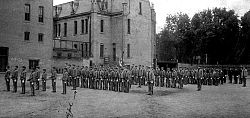All Hallows College offered a Catholic education in early Utah

By Gary Topping, Diocese of Salt Lake City archivist Of all of the projects undertaken by the Right Rev. Lawrence Scanlan, first Bishop of Salt Lake, the most remarkable may have been All Hallows College, for the existence of a Catholic college with a prep school and four-year baccalaureate program in Utah in the 1880s is hard to imagine. But the visionary Bishop Scanlan, obviously inspired by his happy years at All Hallows College, Dublin, believed that a full range of Catholic education ought to be available even in Utah. Unfortunately, even though the college succeeded far beyond any reasonable expectations, its history was not a happy one, for it ended in acrimony, futility and bankruptcy. The school had its beginnings in 1881 when then-Father Scanlan purchased a lot at Second South and Fourth East, only three blocks from the future site of the Cathedral of the Madeleine. Designed by architect Henry Monheim, the building was completed and opened for classes in 1886. Bishop Scanlan was one of the faculty members and even resided at the college from 1887-89. By that time, though, it had become apparent that the limited resources of the diocese were falling far short of what it took to administer such an ambitious undertaking, and Bishop Scanlan was able to persuade the Marist Fathers to purchase and take over the school. The Marist faculty, like those in most colleges, was a rich stew of eccentricity, from Father Theodore Roeser, who took almost every waking breath through a tobacco pipe; to Father Aloysius Duclos, who kept a St. Bernard that guarded his owner so zealously that "anyone else coming close could expect to have canine teeth sunk into the back of his trousers." The college’s curriculum, though, was anything but eccentric, offering courses in three basic programs: Classical, Scientific, and Commercial. Extracurricular activities were rich, from the band and orchestra directed by Professor Anton Pederson, a Mormon musician of repute, to the no fewer than four football teams the school could field. As one would expect, most of the students were Utahns, but the school drew students from other intermountain states as well, and others from as far away as Oregon, California, Nebraska and Pennsylvania. At its peak, the college’s total enrollment was about 200. But trouble dogged the Marists from the beginning, and much of it came from Bishop Scanlan. His ongoing feud with the Marists ranged over issues from the reasonable to the trivial. For one thing, he suspected the college’s beautiful chapel of siphoning parishioners from the Cathedral. Accordingly, he refused diocesan faculties to the priests and demanded that they administer the sacraments only to the students. He condemned athletic competition with other schools, repeatedly accused the fathers of deficient academic standards, and even exploded at the proposal for a dance ("Cadet Hop") at the school. The demise of the college, though, came from forces mostly outside its control. By the early twentieth century, the proliferation of other Catholic colleges in the West rendered Salt Lake City a less desirable educational destination than Seattle, Portland or San Francisco, so the student population dwindled, as did tuition revenues. Most of the remaining students were Utahns, yet Bishop Scanlan refused diocesan financial support, nor would he turn over a parish to the Marists to help support themselves. Finding their position untenable, the Marists pulled out of Utah in 1918. The college buildings were leased to the Utah National Guard, then sold to the state for use as an armory. They were eventually torn down in 1941.
© Copyright 2025 The Diocese of Salt Lake City. All rights reserved.

Stay Connected With Us